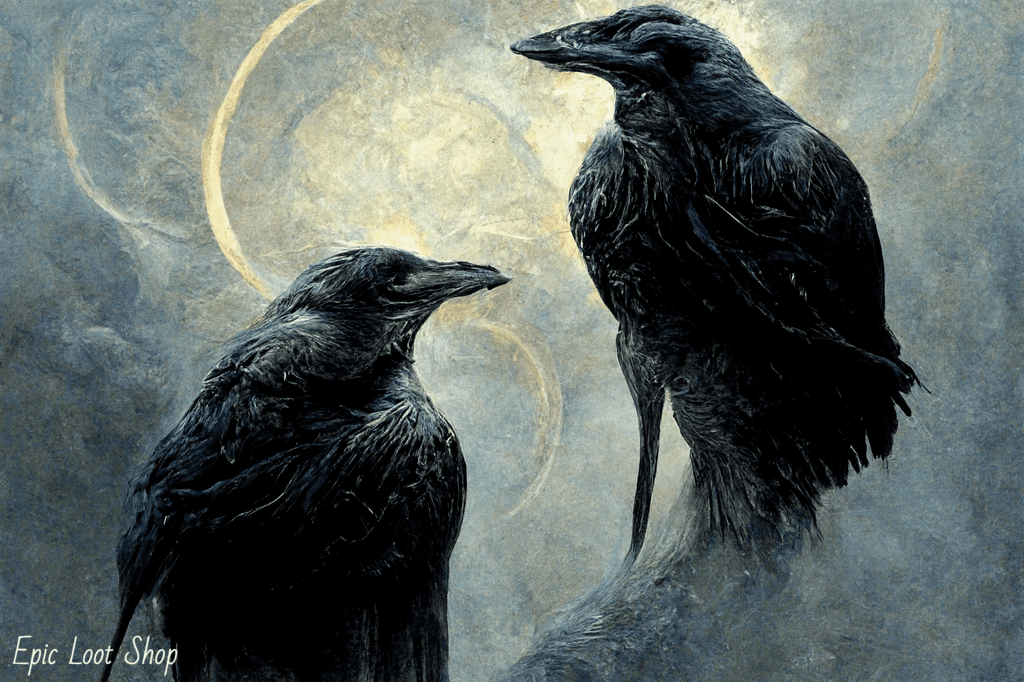Huginn And Muninn: The Ravens Of Odin
You may have heard of Huginn and Muninn, the two ravens sent out from the hall of Odin. They are “thought” by some to be the predecessors of modern-day news. The word Huginn comes from the Old Norse word hoggva, meaning thought or mind. While Muninn is the Old Norse word for memory or mind. However, Odin sent his ravens out at different times to learn what they could, and then they would return to him.
If you've never heard of Huginn and Muninn, they were a pair of ravens used by the Norse God Odin. They were his eyes. He sent them out to the world to gather the information that he could use to help the people. It is told that Odin had two ravens, Huginn and Muninn, who were under his command. Each day the ravens were sent out to fly over the realm of Midgard and observe what happened in mortals' lives. At dusk, they came back to their master with news of all they had seen during their watch. Then they would drink mead together from the drinking horn called Sakar-munir, pass out at Odin's feet, and wake up again at dawn.
Norse mythology is full of strange and bizarre stories but the tale of Odin's ravens, Huginn and Muninn, must have been one of our favorites back in the day. These two feathered friends, along with the wolves Geri and Freki, were shape-shifting companions who helped Odin during his quest for wisdom. In this article, we'll be taking a quick look at these incredible creatures to see what all the fuss was about.
What Do Huginn And Muninn Represent In Norse Mythology? What Is The Meaning Of Their Stories
Huginn and Muninn are two ravens, and they are the most commonly depicted creatures in Norse Mythology. They are the servants of Odin, which is the ruler of Asgard and one of the most powerful gods in mythology. Their names translate to "thought" and "memory". The myth of these two ravens is an interesting one because it seems that there are multiple meanings to their stories. The first is where Huginn and Muninn are said to be two ravens that sit on Odin's shoulders, but there's some speculation as to whether they're actually Odin's eyes or his mind. Another story has them flying around Midgard (the earth) every day and reporting back to Odin about all of the happenings on earth. Many believe that this was a way for Odin to see what was happening on earth without having to leave Asgard, and others say that seeing isn't really what Odin needed to know but rather hearing. Yet another legend says that Huginn and Muninn have no meaning at all, but were created by a poem writer who needed something else for his poem so he made up the story about these two black birds with white breasts.
Huginn and Muninn, the ravens of the Norse god Odin, are often portrayed as his most trusted agents: they fly around Midgard (the human world) gathering intelligence for him each day, only to return to their master's side at night to report on what they've observed. There's a very good reason why this bird is a staple of the lore surrounding Odin—they're both extremely smart and talented at getting information.
Huginn and Muninn occupy a special place in Norse mythology as the two most prolific figures of prophecy. They are also referred to as "the ravens" in some translations, but their names are actually derived from more complex concepts in Old Norse. The word "hugr" can be translated as "thought" or "mind", and "munr" is related to the concept of memory. These two characteristics of Huginn and Muninn are important when considering their role in the stories told about them.
Where are Huginn and Muninn?
Huginn and Muninn were originally a pair of wolves that guarded the entrance to the Underworld. One day (the story does not say how) they are transformed into ravens, with Huginn becoming white (or pure) and Muninn becoming black (or dark). The gods gave them their names: "Huginn" means thought and "Muninn" means memory.
Huginn, the "thought" raven, flies out first at dawn, during which he reflects on all the events he witnessed while everyone was sleeping; Muninn—the "memory" raven—follows him at dusk, bringing back all the thoughts from the day before. The two ravens are often depicted perched on either side of Odin's throne Hliðskjálf (meaning "slope of skulls"), one looking into the distance towards what has yet to come, one gazing into the past to recall what has already happened.
It makes sense that Odin would use such vigilant messengers to keep track of everything that happens in the world: he is a god known for his wisdom, but he also has much to fear from those who could bring about his downfall. Being able to know what others are thinking gives him an advantage over his foes and also allows him to better understand those around him
In a friendly tone: Huginn and Muninn, known as Hugin and Munin in Old Norse, are ravens that fly around the nine worlds and bring information to the god Odin. Actually, "raven" is probably a poor translation, since they're often depicted as doves or some other bird. Even ravens can be a bit of a stretch since in Norse mythology they're not just birds—they are magical, shape-shifting creatures that can take on any form.
It's been said that every time these birds land on earth, one of them turns into an old man and the other into a young man. Their names mean thought and memory respectively, so they are often interpreted as symbols of thought and memory—that is to say, symbols of knowledge that Odin has gained throughout his life. Though in most depictions they simply fly around bringing him news from the world, they were also said to perch on his shoulders from time to time when he was trying to make decisions.
Finally, it seems worth mentioning again that Huginn and Muninn are not exactly ravens. While the idea of flight has been traced back to a well-known Norse story, the overall role of the ravens speaks very much to the fantastical side of Norse mythology, a point in which many scholars see as clear evidence of cultural or contemporary influences on older traditions. Whatever the case, Huginn and Muninn are powerful symbols of immortality and serve an important role to those who seek guidance and knowledge over death.
Overall, Huginn and Muninn proved to be a formidable duo for Odin. They provided him with all-important information, so that he may form a better strategy for his next battle. Through their eyes, he was able to see through the walls of space and time as no man could, sharing in the gift of poetry, whose structure and form were much like his own existence: intangible yet omnipresent if only one knew how to look.
With that said, it shouldn't surprise anyone that there's a very strong Norse mythology theme to Huginn and Muninn. The story of Odin and his ravens isn't a cheerful one — to sum it up, Odin learns magic from a sorcerer named Mimir – at the price of one of his eyes. He then has his two ravens pluck out the other eye to gain even more knowledge, making him a walking embodiment of the proverb "knowledge is power." From there, Odin loses his ability to see anything at all — except for what his ravens see (and in fact, this is where the concept of "bird's-eye view" comes from).




Leave a comment